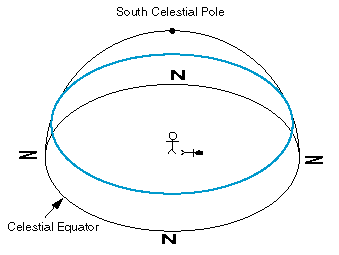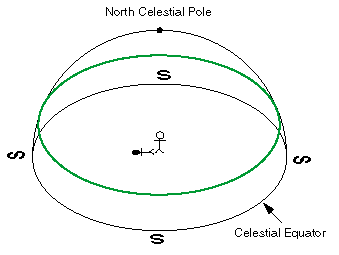
At the north pole (latitude=+90°), the north celestial pole (NCP) is at zenith and the celestial equator lies on the horizon. Thus the northern hemisphere of the celestial sphere always exactly corresponds to the sky. As the celestial sphere turns about the NCP, no stars rise or set, instead the same set of stars is up all the time. If Sun is north of the celestial equator (a positive declination) it too will be above the horizon all the time. Thus on a June day the Sun makes a slow 360° circuit always the same altitude above the horizon. (For example, all day on about June 21 the Sun will be 23½° above the horizon.) It is up throughout the 24 hour day; night must wait for the Sun to go below the celestial equator after the Fall equinox (about September 21). Thereafter, and on a December day, the Sun is below the celestial equator, and hence below the horizon. It is dark throughout the 24 hour day, sunrise must wait for the Sun to go above the celestial equator after the vernal equinox (about March 21).

In Minnesota (latitude=+45°), the north celestial pole (NCP) is midway between zenith and the northern horizon. Except exactly at the poles, half of the celestial equator is above the horizon, as the celestial equator exactly meets the east and west points on the horizon. Some stars are always above the horizon (the circumpolars), but other stars (approximately speaking) rise in the east and set in the west as the celestial sphere rotates about the NCP. Near the southern horizon we can see stars that lie below the celestial equator, and hence were not visible at the north pole. On a June day the Sun rises a bit north of due east and sets a bit north of west. With more than half of its path above the horizon, the Sun is up more than 12 hours. On a December day the Sun rises a bit south of due east and sets a bit south of due west. With less than half of its path above the horizon, the Sun is up less than 12 hours. The altitude of the Sun when it culminates is higher in June than in December. (June is hotter than December because the Sun is above the horizon longer, and the Sun is higher in the sky, so the Suns rays are less spread out.) Note that in Minnesota the Sun does not go through zenith, one must be in the Tropics (Tropics: 23½° > latitude > -23½°) for the Sun to ever be at zenith.
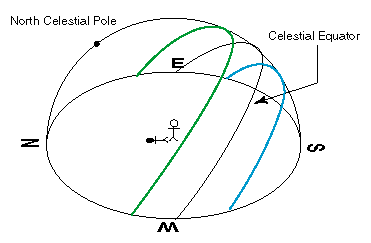
At the equator (latitude=0°), the north celestial pole (NCP) is on the northern horizon and the south celestial pole (SCP) is on the southern horizon. The celestial equator is a vertical circle and hence goes through zenith. Over a day, as the celestial sphere turns about the NCP, the entire celestial sphere is revealed. On a June day the Sun rises a bit north of east, and in fact remains in the northern half of the sky all day: passing north of zenith and setting north of west. On a December day the Sun rises a bit south of east and in fact remains in the southern half of the sky all day: passing south of zenith and setting south of west. On an equinox the Sun would pass right overhead. Notice that there's not much difference in the behavior of the Sun during the year. It's always above the horizon for 12 hours, and it always culminates quite high in the sky. In fact, in terms of daylight and "directness" of sunlight, June is exactly like December; the Sun is only slightly more effective near the equinoxes (March and September).
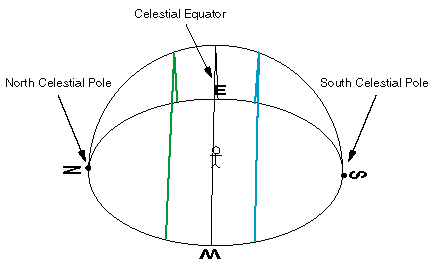
In New Zealand (latitude=-45°), the north celestial pole (NCP) is below the horizon and south celestial pole (SCP) lies midway between zenith and the southern horizon. On a June day the Sun rises a bit north of due east and sets a bit north of west. With more than half of its path below the horizon, the Sun is up less than 12 hours. On a December day the Sun rises a bit south of due east and sets a bit south of due west. With more than half of its path above the horizon, the Sun is up more than 12 hours. The Sun always culminates north of zenith. The altitude of the Sun when it culminates is higher in in December than in June. (December is hotter than June because the Sun is above the horizon longer, and the Sun is higher in the sky, so the Suns rays are less spread out.)
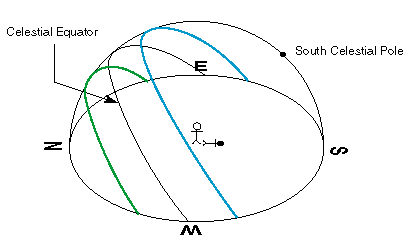
At the south pole (latitude=-90°), the south celestial pole (SCP) is at zenith and the celestial equator lies on the horizon. Thus the southern hemisphere of the celestial sphere always exactly corresponds to the sky. As the celestial sphere turns about the SCP, no stars rise or set, instead the same set is up all the time. On a December day the Sun makes a slow 360° circuit always the same altitude above the horizon. (For example, all day on about December 21 the Sun will be 23½° above the horizon.) It is up throughout the 24 hour day; night must wait for the Sun to go north of the celestial equator after March 21 Thereafter, and on a June day, the Sun is north of the celestial equator, and hence below the horizon. It is dark throughout the 24 hour day, sunrise must wait for the Sun to go south of the celestial equator after the September equinox.
